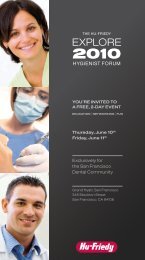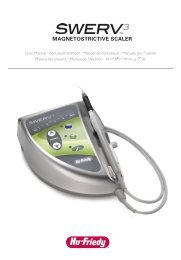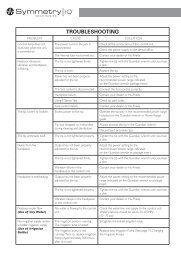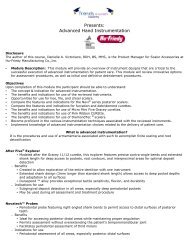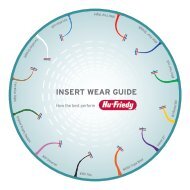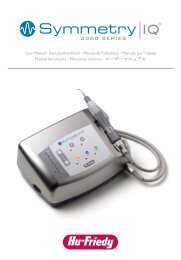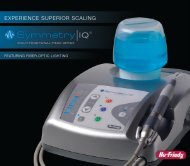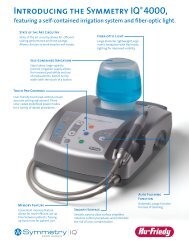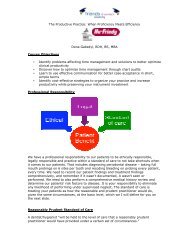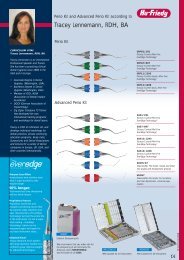Effective and Productive Instrument Processing - Friends of Hu-Friedy
Effective and Productive Instrument Processing - Friends of Hu-Friedy
Effective and Productive Instrument Processing - Friends of Hu-Friedy
Create successful ePaper yourself
Turn your PDF publications into a flip-book with our unique Google optimized e-Paper software.
Table 3. Heat Sterilization Methods<br />
Method Temperature/Pressure Exposure Time (a) Advantages Precautions<br />
Steam autoclave (b) 121°C (250°F)<br />
13-30 min<br />
- Good penetration - Non-stainless steel items corrode<br />
115 kPa<br />
3.5-12 min<br />
- Nontoxic<br />
- May damage rubber & plastics<br />
134°C (273°F)<br />
216 kPa<br />
- Time efficient<br />
- Cannot use closed containers<br />
- Unwrapped items quickly contaminated after cycle<br />
Dry heat (c)<br />
160°C (320°F) 60-120 min - No corrosion<br />
- Long cycle time<br />
(oven-type)<br />
- Nontoxic<br />
- May damage rubber & plastics<br />
- Items are dry after cycle - Door can be opened during cycle, disrupting sterilization<br />
- Can use closed<br />
- Unwrapped items quickly contaminated after cycle<br />
containers (d)<br />
- Many wraps <strong>and</strong> pouches are not compatible<br />
Dry heat (c)<br />
191°C (375°F) 12 min wrapped - No corrosion<br />
- May damage rubber & plastics<br />
(rapid heat transfer)<br />
6 min unwrapped - Nontoxic<br />
- Door can be opened during cycle<br />
- Time efficient<br />
- Unwrapped items quickly contaminated after cycle<br />
- Items dry quickly<br />
- Many wraps <strong>and</strong> pouches are not compatible<br />
Unsaturated<br />
134°C (273°F) 216 kPa 20 min - No corrosion<br />
- May damage rubber & plastics<br />
chemical vapor (b)<br />
- Time efficient<br />
- Cannot use closed containers<br />
- Items dry quickly<br />
- Must use special solution<br />
- Uses hazardous chemical<br />
- Unwrapped items quickly contaminated after cycle<br />
(a) These exposure times relate only to the sterilization portion <strong>of</strong> the total cycle <strong>and</strong> do not include any warm-up, come-down or drying times. The exposure<br />
time may vary depending upon the load <strong>and</strong> should be verified during actual use with biological monitoring (spore-testing) <strong>and</strong> chemical indicators.<br />
(b) Monitor with spores <strong>of</strong> Bacillus stearothermophilus.<br />
(c) Monitor with spores <strong>of</strong> Bacillus subtilis.<br />
(d) Confirm by using biological indicator on inside <strong>of</strong> container.<br />
Adapted from: Miller, CH: Update on heat sterilization <strong>and</strong> sterilization monitoring. Compend Contin Educ Dent 1993;14:304-316.<br />
reprocessing instruments. Choosing a reliable, effective instrument<br />
management system <strong>and</strong> protocol that minimizes risk <strong>and</strong><br />
stress, maximizes productivity, saves money, <strong>and</strong> limits damage to<br />
instruments is essential for DHCPs, patients <strong>and</strong> the practice.<br />
References<br />
1 Tortora G, Funke B, Case C. 2007. Microbiology: An Introduction (9th Edition),<br />
408-431.<br />
2 Bently CE, Burkhart NW, Crawford JJ. Evaluating spatter <strong>and</strong> aerosol contamination<br />
during dental procedures. J Am Dent Assoc. 1994;125(5):579-84.<br />
3 Martin MV. New Concepts in Cross-Infection Control in Dentistry. Brit Dent J.<br />
June 8, 1990.<br />
4 Miller CH, Palenik CJ. Infection Control & Management <strong>of</strong> Hazardous Materials<br />
for the Dental Team. 3rd Edition, Elsevier Mosby, St. Louis, Mo., 2005.<br />
5 CDC. Guidelines for Infection Control in Dental Health-Care Settings, 2003.<br />
MMWR 2003:52 (No. RR-17).<br />
6 CDC Guidelines: From Policy to Practice by OSAP, 2003, Annapolis, Md.<br />
7 Palenik CJ, Burke FJT, Coulter WA, Cheung SW. Cross-Infection Control,<br />
Improving <strong>and</strong> Monitoring Autoclave Performance in Dental Practice. Brit Dent J.<br />
1990;187:581-84.<br />
8 Kurita H, Kurashina K, Honda T. Nosocomial transmission <strong>of</strong> methicillinresistant<br />
Staphylococcus aureus via the surfaces <strong>of</strong> the dental operatory. Br Dent J.<br />
2006;201(5):297-300.<br />
9 Kohn WG, Collins AS, Clevel<strong>and</strong> JL, Jarte JA, Eklund KJ, Malvitz DM. Center for<br />
Disease Control <strong>and</strong> Prevention. Guidelines for infection control in dental healthcare<br />
settings, 2003. MMWR recomm Rep. 2003;52 (RR-17):1-16.<br />
10 Molinari JA, Palenik CJ. Environmental surface infection control. Compend Contin<br />
Ed Dent. 2004;25(suppl):30-7.<br />
11 Andrews, N. A Clean Sweep, RDH Magazine, Nov. 2008.<br />
12 Ramos-Gomez F, Ellison J, Greenspan D, Bird W, Lowe S, Gerberding JL. Accidental<br />
Exposures to Blood <strong>and</strong> Body Fluid Among Health Care Workers in Dental Teaching<br />
Clinics: A Prospective Study. J Am Dent Assoc. 1997;58(3):217-20.<br />
13 Panagakos FS, Silverstein J. Incidence <strong>of</strong> Percutaneous Injuries at a Dental School:<br />
A Four-Year Retrospective Study. Am J Infect Control. 1997;25:330-4.<br />
14 OSAP, Managing patient care items <strong>and</strong> environmental surfaces. (Appendix C).<br />
From Policy to Practice: OSAP’s Guide to the Guidelines. Annapolis, Md.: OSAP,<br />
2004:142.<br />
15 Sanchez E, Mac Donald G. Decontaminating dental instruments: testing the<br />
effectiveness <strong>of</strong> selected methods. J Am Dent Assoc. 1995;126;359-62.<br />
16 Miller CH, Palenik CJ. Infection control & management <strong>of</strong> hazardous materials for<br />
the dental team (3rd Edition). Elsevier Mosby, St. Louis, Mo., 2005.<br />
17 U.S. Department <strong>of</strong> Labor, Occupational Safety <strong>and</strong> Health Administration. 29<br />
CFR part 1910.1030, Occupational exposure to bloodborne pathogens, final rules.<br />
Federal Register 1991,56(235)64004-64182.<br />
18 Younai FS, Murphy CD, Kotelchuck D. Milieu in Dental Schools <strong>and</strong> Practice,<br />
Occupational Exposure to Blood in a Dental Teaching Environment: Results <strong>of</strong> a<br />
Ten-Year Surveillance Study. J Dent Ed.; 65(5):426-48.<br />
19 CDC. Guidelines for environmental infection control in health-care facilities:<br />
recommendations <strong>of</strong> the CDC <strong>and</strong> the Healthcare Infection Control Advisory<br />
Committee. MMWR 2003; 52(no. RR-10) Oper Dent. 2005;30(1):16-25.<br />
20 Organization for Safety <strong>and</strong> Asepsis: Position Paper: <strong>Instrument</strong> <strong>Processing</strong>, Jan.<br />
1997. Accessed Sept. 2008.<br />
21 Rutala WA, Weber DJ. Choosing Sterilization Wrap for Surgical Packs. Infect Cont<br />
Today. 2000;4:64-70.<br />
22 Organization for Safety <strong>and</strong> Asepsis Procedures Research Foundation. Monthly<br />
Focus: The Sterilization Process. Annapolis, Md.: OSAP, 1997.<br />
23 Centers for Disease Control. Guideline for Disinfection <strong>and</strong> Sterilization in<br />
Healthcare Facilities, 2008. Available at: www.cdc.gov/ncidod/dhqp/pdf/<br />
guidelines/Disinfection_Nov_2008.pdf. Accessed Nov. 2008.<br />
24 Association <strong>of</strong> the Advancement <strong>of</strong> Medical <strong>Instrument</strong>ation. Chemical indicators:<br />
guidance for the selection, use <strong>and</strong> interpretation <strong>of</strong> results. AAMI Technical<br />
Information Report No 25. Arlington, Va.: Association for the Advancement <strong>of</strong><br />
Medical <strong>Instrument</strong>ation, 1999.<br />
25 Nickerson P, Bhuta G, Orton B, Alvin B. Monitoring dental sterilizers’ effectiveness<br />
using biological indicators. J Dent Hyg. 1990;64(2):69-73.<br />
26 Rosa AC et al. Effects <strong>of</strong> H<strong>and</strong>ling <strong>and</strong> Storage on Sterile Dental <strong>Instrument</strong>s. Acta<br />
Odontol Lainoam. 2001;14(1-2):35-39.<br />
Author Pr<strong>of</strong>ile<br />
Noel Br<strong>and</strong>on Kelsch, RDHAP<br />
Noel Br<strong>and</strong>on Kelsch is a freelance cartoonist, writer, international speaker <strong>and</strong><br />
Registered Dental Hygienist in Alternative Practice. Her articles have been published<br />
in dental <strong>and</strong> nursing trade magazines. She has written articles for National<br />
Journals <strong>and</strong> Corporations on Methamphetamine abuse. Her passion for getting<br />
information to the dental pr<strong>of</strong>essional <strong>and</strong> the public on the oral effects <strong>of</strong> this<br />
devastating drug has taken her from NBC news to ESPN. Noel has received many<br />
national awards including Colgate Bright Smiles Bright Futures, RDH Magazine<br />
Sun Star Butler Award <strong>of</strong> Distinction, USA magazine Make a Difference Day<br />
award, Presidents Service award, Foster Parent <strong>of</strong> the Year, <strong>and</strong> is a five-time winner<br />
<strong>of</strong> the Castroville Artichoke cook <strong>of</strong>f! Noel is the current President <strong>of</strong> California<br />
Dental Hygienists Association, a member <strong>of</strong> Organization for Safety <strong>and</strong> Asepsis<br />
Procedures <strong>and</strong> board member <strong>of</strong> Simi Valley Free Clinic.<br />
Disclaimer<br />
The author(s) <strong>of</strong> this course has/have no commercial ties with the sponsors or the<br />
providers <strong>of</strong> the unrestricted educational grant for this course.<br />
Reader Feedback<br />
We encourage your comments on this or any PennWell course. For your convenience, an<br />
online feedback form is available at www.ineedce.com.<br />
www.ineedce.com 9



